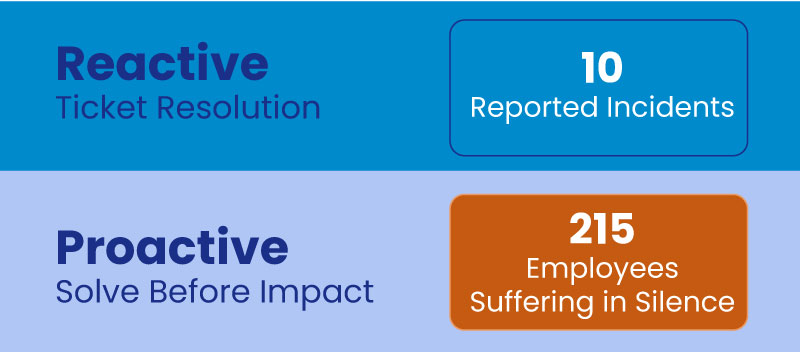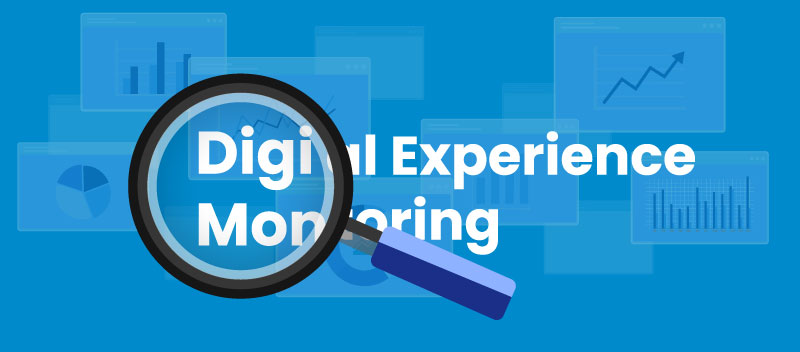As the Work from Anywhere (WFA) culture has taken hold over the past few years, it has become essential for IT operations groups to maintain oversight with proactive experience management of their knowledge workers. While businesses continue their digital transformation, every employee is dependent on workplace technology to be successful at their role, especially if they work remotely. But the bad news is that many employees will not report lagging performance issues to IT support.

According to a recent Forrester Research study from May 2022, many users will never contact the IT service desk. If they experience performance problems on their computers or with their cloud-based services like Microsoft 365, they will just continue to suffer in silence. They won’t report the problem and their issues will linger. This puts the responsibility on the IT operations group to proactively identify those users and troubleshoot their problems.
This article will discuss the benefits of proactive experience management through predictive and preemptive analytics. In addition, it will provide an outline of the requirements for effective Digital Experience Monitoring (DEM) solutions and the modernized processes required to leverage the actionable insights they provide.
The Dawn of a New Age for Digital Experience Monitoring
Digital workplace technology is evolving fast, fueled by the post-pandemic realization that employees can work from anywhere, given the right tools to stay productive. The cornerstone supporting this new model is of course IT operations. They are ultimately responsible for the technology-driven productivity and satisfaction of their organizations. But how can they be successful if they are flying blind, oblivious to any chronic digital experience issues?
Modernized IT operations groups are now reliant on DEM solutions to provide the level of visibility they need to spotlight issues and come to the rescue. And that visibility needs to enable proactive, data-driven decisions for fast troubleshooting. Proactive visibility refers to the ability to look beyond user-reported issues and detect problems before a service desk ticket is raised or, better yet, before they can negatively impact end-users. Why is this important? Because, as stated in the Forrester Research article, many employees with performance problems will continue to suffer in silence without contacting the IT service desk.
Based on the metrics included in the Forrester Research report, there are huge opportunities for proactive troubleshooting of unreported issues, as shown in the graphic example below.

Proactive Experience Management: Visibility and Preemptive Analytics
As described earlier, IT operations groups have the sole ownership to identify employees suffering from poor digital experiences and help them. But digital performance problems are not as immediately apparent to IT teams. They often lurk below the radar of service desks because employees aren’t reporting an issue. There’s no trouble ticket to alert the responsible IT support group, so everything seems fine. But don’t be fooled; even without rising ticket counts, these performance issues negatively impact IT operations and their digital transformation projects. According to McKinsey, 70% of all digital transformation programs fail due to employee resistance to the deployed technology.
A modernized IT operations group needs a deep level of detail about digital experiences to perform predictive and preemptive analytics. This empowers them with a proactive, data-driven IT strategy to detect and resolve the root cause of incidents before chronic issues become bottlenecks to technology adoption. This type of proactive visibility and actionable insights is essential for digital experience optimization. Because being aware of an issue is one thing, being able to fix it quickly and prevent it from impacting more employees is another.
This is where predictive and preemptive analytics play a role. Instead of focusing on ticket resolution, IT can shift left and solve issues before impact. They can leverage the telemetry data from a new age DEM solution to detect non-reported issues across the entire organization and scale any troubleshooting across both impacted and non-impacted users. But how do you pick the best toolset to gather and organize the plethora of accurate data to analyze?
Picking the Right Digital Experience Monitoring Solution
So, if the responsibility for IT operations is to proactively identify digital experience issues for their employees, quickly assess the problem and implement a fix, how do they do it? Well, they start by focusing on supporting people, not machines. To achieve that, they need the right DEM tool to empower them with complete visibility into the end-to-end digital journey for employee activity.

This level of visibility and preemptive analytics is only possible with a deep, holistic, data-driven understanding of the digital employee experience. A single pane-of-glass to see how every employee, device, computing environment, application, and network function together and impact the employee experience. And to spotlight users with issues, it requires specific telemetry data with the appropriate viewpoint — a solution that tracks performance from the end–user perspective, from their endpoint devices, and provides the actionable insights to identify the chokepoints causing the problems.
And be sure to consider today’s environment with knowledge workers accessing systems and collaborating from anywhere. Once you do, it’s easy to see why certain legacy DEM tools are lagging in business value. Those old monitoring solutions have known blind spots when it comes to employees working outside of an office building. Today’s new hybrid work structure allows employees to decide where they work (home office, ISP, Wi-Fi), and how they work (preferred hardware). Sure, IT provides them with the options and means to connect securely, but most elements are now decided by the user, including their unmanaged networks and external ISPs.
Taking all this into account will help your approach to evaluating and choosing the best DEM solution for your organization. And remember, all the background data and telemetry metrics should be organized and available in a single pane-of-glass. Having performance data stored in different siloed repositories is a nightmare. This includes statistics from user endpoint performance monitoring, synthetic transaction monitoring, and network performance. In addition, the solution should provide graphical dashboards and simple drill-down reports that empower IT operations groups, including the service desk, to perform preemptive analytics and identify the responsible areas that are most likely causing the problems. Because knowing every metric, even every glitch, is not equal to being able to solve the problem.
Optimizing the Digital Experience for Your Employees
The future of proactive experience management is not to fix more issues faster, it is to stop issues from happening in the first place by fixing them before they can reach critical mass. Using preemptive visibility strategies and the right DEM tool, IT teams can identify the root cause of issues and push fixes across the entire digital ecosystem. This approach to digital experience optimization will not only reduce the number of IT tickets at the service desk but will also prevent the issue from impacting any other employees in the future.
With today’s cloud services deployed as critical communication and collaboration tools like Microsoft Teams, SharePoint, Salesforce, ServiceNow, etc., a solid digital experience optimization strategy allows organizations to be agile and quickly identify issues proactively. It also allows IT teams to react quicker with faster response time to research any reported issues. And there are multiple business benefits that come from providing an excellent digital experience for your users. It helps with both employee retention and with recruiting new talent. The millennial candidates in today’s workforce have high expectations for modern technologies and flexible working locations. And they will see a lagging digital experience as a huge red flag.
If you are interested in finding out more about our DEM solution, OfficeExpert, and how it can help you with proactive experience management for your organization, please visit our overview page online, or sign-up for a trial at panagenda.com/products/officeexpert.

